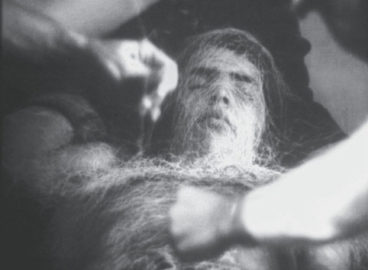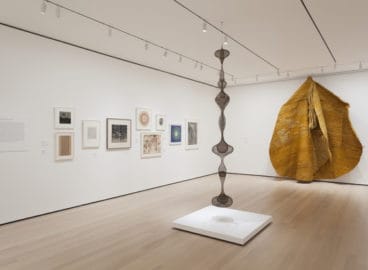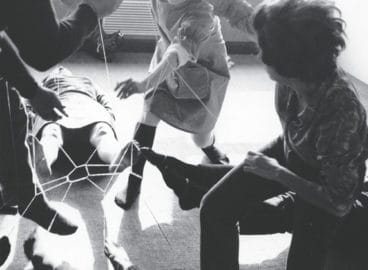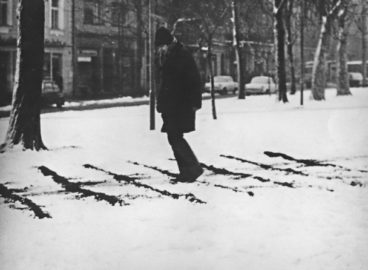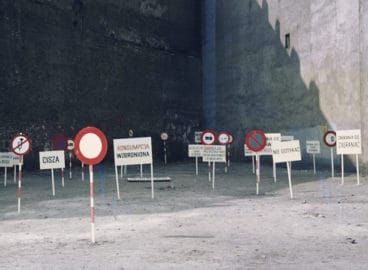Mondolat
Miklós Erdély

If something is big enough to be infinite, then it may be considered to be a whole, indivisible and elemental.
If something is small enough to be elemental and indivisible, then it may be considered to be a universe, whole and infinite.
If something is small or large enough to be whole, it is senseless to divide or multiply it because the infinite ultimately remains identical to itself.
Everything elemental is itself whole, just as the whole is there in everything elemental—as parity.
You cannot take a count of that which is identical to itself. (You cannot take a count of your mother because she is always the same She.)
Thus it is not possible to draw a distinction between the one and the many, because it is one and the same.
If you can recognize, if not imagine, that what is increasingly smaller cannot wind up anywhere else but to the whole, and what is increasingly larger cannot lead anywhere else than to the smallest possible; if you can recognize, if not imagine, that the entirely small is nothing other than the whole, then you can never be disconsolate, because there is nothing more to recognize.
If you direct your gaze in two different directions: at the increasingly small and at the inconceivably large, then you realize that you are seeing exactly the same thing, and your daily sorrow will disappear.
If you direct your gaze at the endless multitude of things and realize that the many is identical to the one, and that the one is one and the same as many ones, then you will realize that there is neither many, nor one, and your death will also disappear.
If you always find on the opposite side that which you have turned your back upon, then you can never go astray.
If you are capable of thinking in constant and sudden inflections, then your thought becomes prayer and practice.
Do you believe that until the whole finds its way, by dividing, back to itself, it can take the form of a horse, a camera, or anything at all?
Because many times one is too many only when it is more of the same, but it makes no difference that it is too many as long as the many ones are all one and the same.
If you understand with time in what manner that which is, is not, then you will understand it in its own name, and its name becomes a stronger reality. As you depart, see it in increasingly sharper focus!
If you do not subordinate your fate, if you are happy, and everything comes to you as you desire; if everything in its entirety pleases you, and your condition is truly good, then, departing, restore all that already appeared to be you, so that you do not deviate from your position as an outsider. But do not say that it is an illusion—lest you lose it.
(Translator’s note: “Mondolat” is a word created in the early 19th century, during the movement to reform the Hungarian language. It was the title of a satire against the reformers, and was meant as a “new” Hungarian word for the Latin oratio. At the same time, it is an untranslatable play on words combining the elements: Say–Thought–Sentence.)
Translated by John Bátki
*The text was read by Erdély in 1973 as part of his performance in the Ganz-MÁVAG Cultural Center, Budapest. First published in: Magyar Műhely [Hungarian Atelier], vol. 21, no. 67, July 15, 1983, pp.60–61, republished: AL/6, September 1983, pp.41-42; Szógettó [Word-ghetto]. Jelenlét [Presence], 1989/1–2 (14–15), p.98; in: E. M.: Második kötet [Volume Two], Selected and eds.: Beke, László, Miklós Peternák and the editors of Magyar Műhely. Magyar Műhely, Paris, Vienna, Budapest, 1991, pp.5-6; In the essay of Annamária Szőke entitled: “Titok a jövő jelenléte” Tudomány a művészet határain belül Erdély Miklós művészetében [“The Presence of the Future is Secret”. Science within the boundaries of Art in the Oeuvre of Miklós Erdély]. Nappali Ház, vol. IX, no. 1, 1997/1, pp.52-53. In German: Mondolat (Übersetzt von Hannelore Schmör-Weichenhain). Acta Historiae Artium, Tomus 39, 1997, p.215.
© Heirs of Miklós Erdély, the translator, the Miklós Erdély Foundation
The original Hungarian text has been published by the Artpool Art Research Center and can be accessed online here.
